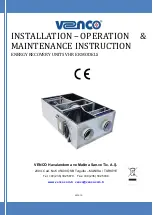
www.lifebreath.com
27
18
T
ROUBLESHOOTING
Refer to the following table for troubleshooting the HRV unit.
Table 17.1
–
Troubleshooting Procedures
SYMPTOM
CAUSE
SOLUTION
Poor airflows
•
1/4 in (6mm) mesh on outside
hood is plugged
•
Filters plugged
•
Core obstructed
•
House grilles closed or blocked
•
Dampers are closed if installed
•
Poor power supply at site
•
Ductwork is restricting HRV
•
Improper speed control setting
•
HRV airflow improperly balanced
•
Clean exterior hoods or vents
•
Remove and clean filter
•
Remove and clean core
•
Check and open grilles
•
Open and adjust dampers
•
Have electrician check supply voltage
•
Check duct installation
•
Increase the speed of the HRV
•
Have contractor balance HRV
Supply air feels cold
•
Poor location of supply grilles, the
airflow may irritate the occupant
•
Outdoor temperature extremely
cold
•
Locate the grilles high on the walls or under
the baseboards, install ceiling mounted diffuse
or grilles so as not to directly spill the supply
air on the occupant (i.e. over a sofa)
•
Turn down the HRV supply speed. A small
duct heater (1 kW) could be used to temper
the supply air
•
Placement of furniture or closed doors is
restricting the movement of air in the home
•
If supply air is ducted into furnace return, the
furnace fan may need to run continuously to
distribute ventilation air comfortably
Dehumidistat is not
operating
•
Outdoor temperature is above
15°C (59°F)
•
Improper low voltage connection
•
External low voltage is shortened
out by a staple or nail
•
Check dehumidistat setting it may
be on OFF
•
Dehumidistat is functioning normally (see
Auto Dehumidistat Disable in this manual)
•
Check that the correct terminals have been
used
•
Check external wiring for a short
•
Set the dehumidistat at the desired setting
Humidity levels are too
high condensation is
appearing on the windows
•
Dehumidistat is set too high
•
HRV is not sized to handle a hot
tub, indoor pool etc.
•
Lifestyle of the occupants
Moisture coming into the home
from an unvented or unheated
crawl space
•
Moisture is remaining in the wash
room and kitchen areas
•
Condensation seems to form in
the spring and fall
•
HRV is set at too low a speed
•
Set dehumidistat lower
•
Cover pools, hot tubs when they are not in
use
•
Avoid hanging clothes to dry, storing wood
and venting clothes dryer inside. Firewood
may have to be moved outside
•
Vent crawl space and place a vapor barrier on
the floor of the crawl space
•
Ducts from the washroom should be sized to
remove moist air as effectively as possible,
use of a bathroom fan for short periods will
remove additional moisture
•
On humid days, as the seasons change, some
condensation may appear but the homes air
quality will remain high with some HRV use
Increase speed of the HRV




































